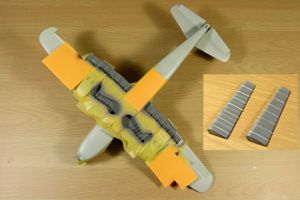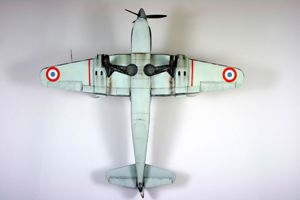
Caudron C.714C1 "Cyclone"
1/32nd scale plastic scale model kit by Azur
with diorama
Historical backgroundThe caudron C714 is based upon a specification developed by the French military, which was proposing a very light aircraft, powered by a small engine. The idea was to generate a light-weight, low cost design, produced from strategically non-critical materials.The inital concept was introduced in the early thirties, and a prototype was proposed by Caudron in 1936. Caudron's experience in racing an record planes helped devising a small, mostly wooden, sleek low-wing, powered by the small Renault 12RO1 450 HP engine. First machines were delivered to the military in 1939, but the concept proved not successful - while higly manouverable, the climb rate of this type was disappointing, and coupled with a number of other design flaws, the C.714 was not introduced to French units. Of the 100 ordered units 50 were sold to Finland, of which 6 arrived there. Polish exile army fighting in France in 1940 employed a few dozens of these planes with some success. |
 
| |
The kitThe kit is Azur's offering, which is a multi-media set, containing 4 basic sprues, one clear sprue, a number of resin details, and a small PE fret. The only bought extra was a set of Montex masks, which this time proved to be excellent.The quality of the kit was surprisingly good, in particular considering its short run origin. The kit is well thought through, and correspondingly engineered, allowing from the start for example for deflected rudders or an open canopy. On elements where sheet metal edges are visible, the material is tapered, to make it appear proportional in thickness. In this scale, a few details need fine tuning, but more of this later. The kit offers a number of variants, but most of them are quite similar, so I decided well into the build that it will be Boleslaw "Mike" Gladych's mount, the white 13, as it presented itself in May/June 1940 in Villacoublay. |
 | |


 | ||
|---|---|---|
AssemblyThe fit of the model proved to be really good for a short run. The cockpit went toghether as a snap, including all the PE bits and pieces. Just the instrument panel needed to be painted by hand, since there were no provisions for this neither in the decals nor in the PE. In the 32nd scale, this proved to be well feasible.A slight challenge was presented by the exhaust system: The pipes sit tight in the corresponding openings, and are nearly flush with the fairing. It would be hard to mask it later. I pre-painted the part of the cowling in the final tones, and after milling open the exhaust ports with a dentist's spherical micro-milling cutter, I located the painted exhaust pipe elements in the fairing. The complete section was then masked with tape till the end of the build. The prop got as usual a bearing - this time from two brass tubes, one located in the other. The engine is well exposed - in the kit it has just half the first cylinder, and ended there with a dead wall. I added the internal parts of the "V" which could be seen, and put the engine in the fuselage. The canopy had to be futured, masked, painted inside, unmasked inside, and then glued to the fuselage. The idea of large segments in clear plastic is a double-edged sword. On one hand, it provides neat positioning of the complex glass panels on the canopy. On the other hand, the fit is not perfect, and forcing the brittle material into shape may result in cracks, as happened to me. Additionally, the different hardness of the gray and clear plastic requires extremly careful sanding at the seam of the canopy with the fuselage. In my case this meant losing most details on the clear part close to the edge, like rivets or handholds. A picture of a Finnish Caudron with open landing flaps brought me also upon the crazy idea of opening these. They looked quite interesting, with perforated stripes on the inner edges. So I cut them out of the wing, toghether with the ailerons. The flaps were detailed with styrene card, in which I drilled the perforations. The situation became tough when fitting them to the wing, which has an inverted gull wing profile, and therefore a complex intersection between the flap and the wing bottom. To achieve a fit, the wing had to be thinned in this area, and sharpened at the edge. Basic ribs were added, made from a foamed PE plate, and rudimentary machine guns housings, which I located below the casings chutes. The ailerons had to be re-built on the inside, and lost texture in the process. I regenerated it by gluing PS stipes, and then sanding them slightly down. The (even in the original) rather boring wheel wells got beefed up by adding a number of lines, cables etc. to the landing gear. |
    | |


 

 

 

 

 | ||
Painting and decalsThe model got the usual Gunze Mr. Surfacer treatment, and a pre-shade with black paint. The color scheme for this particular aircraft was visible only partially on photographs in the available literature, so the paint recommendations from the instruction and available books differer a lot. I decided to go with the instruction.I used the recommended Gunze-Sangyo acrylics which worked excellently for me. The delicate paint scheme had was applied free hand, and I used the very fine Iwata HP-B with a 0,2mm nozzle for the job. The surfaces are considerable, and with the required number of passes, my fingers were really cramped after the process. On top came a coat of Future, then the decals. These are from "dead design" and as the name says, either designed for or by dead, because as usual, they caused problems. While very thin, they are resistant to all softeners known to me (except nitro solvent), and they adhere not very well. The result was a stripped part of the Polish checkerboard insignia, which I had to repair with leftover bits. I decided to paint the rudder straight away, rather then to try my luck with the decals again. Next came the weathering with artist oil in turpentine. In the end everything was sealed by a mix of Future with Tamiya flat base, same like the Hellcat. Nasty surprise came just the next day: the surface was all badly cracked, and the weathering ran into it! Short of despair, I re-orderd X-tra colors XDFF flat varnish, re-sanded the surfaces carefully, overpainted some with the original color, and sealed everything with XDFF. This luckily saved the day, and made the surface look good again. |
   | |


 

 | ||
Finishing touchesI added paint chipping using a small knife, partially using the cracks which occured during the painting as starting spots for ths chips. The wheels got mudded by MiG Pigments and artists chalks, and a trace of dirt spray was applied in the plane of rotation of the wheels.Antennas, cross hair, and the tail light finished the model. And yes, there are no wing tip lights. |
 | |


 

 

 

 |
||
DioramaIt's the only model I have in 32nd scale, and since it was a really small aircraft, it's about the size of some of my 72nd scale collection. In order to show it in relation, I decided to put it in a diorama. Initially, I wanted to have it with a Gnome-Rhone Motorcycle, but not being able to find it, I decided otherwise.My "local dealer" had a few boxes, which would fit nicely: 35th scale Tamiya's French 1940 infantry squad, and MiniArts French tank crew. Out of this I decided to arrange a scene: The mechanics, and an old colonel are having a picnic next to the airplane, while an infantry unit appears and warns them about the approaching Germans. I had to re-arrange the original figures a bit in their gestures, to hold some glasses on one side, and to carry their weapons - rather then directly use them - in the other. For rounding off the scenery I added a piece of fence from MiniArts village accessories, and a small and a big wooden barrel of MiniArts crates and barrels set, later of which is used as a stand for the machine gun. The fence was decorated with ABER's PE wine, and some of the ABER cuttlery and kitchen accessories were added to the spread tarpaulin. The glasses were drawn with a rod from heated acetate, the bottles from clear sprue. I used Gunze's clear acrylics for the wine, which again produced very good effect. Other foodstuff was made from flash-bonder and painted. The grass, as usual, is from railway model supply, glued to a foamed hard plastic plate by the means of double sided tape. It was touched up a little by a large brush and some artists oils. In the end, even though the diorama alread appears crowded, I had to restrain myself from adding even more. The goodies available in the 35th scale are just too much. |
  
| |


 |
||
SummaryOverall a very pleasant build, in spite of the flop with the coating. I was positively surprised about the ideas Azur brought into the break down of the elements. The diorama got quite busy - even though it's looking nice - maybe less would be more.Finally, I'd like to thank my local model shop - the W&W model shop in Rzeszow for ideas and inspiration. Remember! Support your local dealer! SourcesPolish Wings 2 by Bartlomiej Belcarz - Stratus publishing 2007Goryka Slodycz Francji - Grzegorz Slizewski / ZP publishing 2010 |
  | |
RZE
March 2012